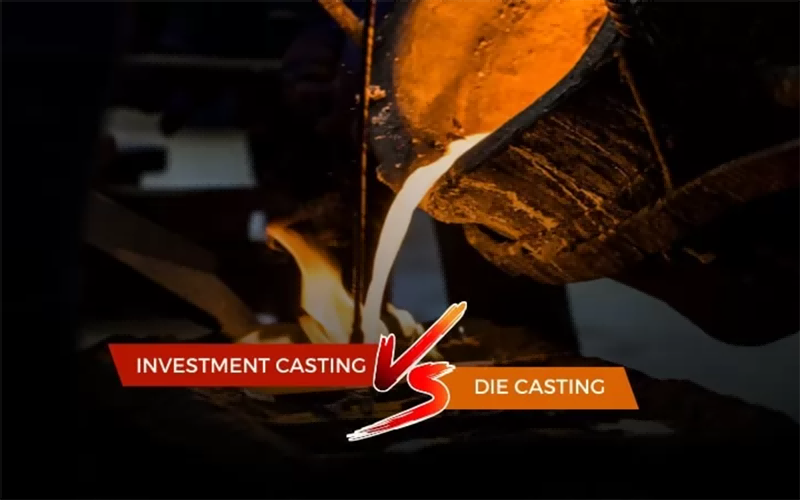Should you choose investment casting or die casting to manufacture your product? Through this article, I hope you can see the answer you want!
What is Investment Casting?
Investment casting, also known as lost wax casting, or lost wax casting, making a part using investment casting is usually a more time-consuming process in which a wax prototype of a part is made and then dipped repeatedly in liquid ceramic. The ceramic hardens, then the wax is melted, leaving a ceramic mold. The molten metal is then poured into the ceramic cavity. Once the metal has solidified, the ceramic mold is broken and removed, leaving the metal casting. Molds used to create wax-ups can be used many times, but ceramic molds are broken and discarded during the production of each part.
Advantages of Investment Casting:
The casting of ferrous and non-ferrous materials.
A smooth surface finish reduces machining and finishing.
Capable of producing thin-walled parts with complex shapes.
With high precision, products with precise dimensions can be directly manufactured without post-processing.
Disadvantages of Investment Casting:
Casting costs are high.
Delivery time is long.
However, every aspect of the XJL investment casting process is automated, effectively reducing lead times.
Common Investment Casting Applications
Investment casting is highly versatile and can be used on a wide range of ferrous and non-ferrous metals. As such, it is used to manufacture many high-precision, high-accuracy components such as aircraft systems, automotive engine and exhaust systems, agricultural equipment, hand tools, construction hardware, sanitary ware, industrial components, and medical equipment.
What is Die Casting?
The die-casting process involves forcing red-hot liquid metal into a mold under extreme pressure. A “mold” in this case is simply a steel pattern created to shape the actual product being manufactured. Once the liquid metal is poured and injected into the mold, it solidifies and is then removed from the mold. Once the liquid metal has cooled, the gate material, which acts as a protective source for the liquid metal, is removed and the product is complete.
Advantages of Die Casting:
High productivity.
Excellent economic effect.
Disadvantages of die casting:
Castings are prone to porosity and cannot be heat treated
Die casting is difficult for complex concave castings
For alloys with high melting points (such as copper, and ferrous metals), die-casting models have a shorter life
Not suitable for low-volume production due to high manufacturing costs
Common Die Casting Applications
Die casting is commonly used to produce small and thin metal parts. These components find applications in many industrial and commercial products such as automobiles and consumer electronics.
Difference Between Investment Casting and Die Casting
While investment casting and die casting employ similar manufacturing principles to produce parts and products, there are distinct differences between the two processes. For example:
1. Investment casting uses disposable molds for each new casting, while die casting uses reusable molds.
2. Investment casting is suitable for both ferrous and non-ferrous metals, while die casting is only suitable for non-ferrous cast metals.
3. Investment casting is ideal for small and medium batch production, while die casting is more suitable for high-volume production.
4. Investment casting parts generally require little secondary machining, while die-cast parts may require post-machining to achieve the desired dimensions and finish.
Investment casting and die casting have unique advantages and limitations that make them suitable for different manufacturing needs. Investment casting is an ideal solution for projects involving small batches of highly precise, complex parts.
Before you start your next project, there are a few things to consider to help you choose which process is right for your part.
When you choose to die casting
1- You need to have a large order
Tooling for die casting is too expensive and requires a lot of work. However, such molds can last up to one million parts produced.
If your order quantity can reach this order of magnitude, the unit cost per die casting will become very low.
2- You need a fast turnaround time
Once the die-casting mold is ready, the production and output of the part become a simple and repetitive process that is perfectly amenable to automation.
3- You need large parts
Die-casting product size is larger than investment casting. Parts of any size can be made with die casting, although it requires more complex and expensive machining. This is not easy with investment casting. It must take into account the requirements of lost wax technology and the pouring process.
When you choose investment casting
1- You need high-precision products
Design freedom and tight tolerances are core areas where investment casting excels. When you’re working with wax models, it’s easy to add subtle design elements. If you need to recreate a model with complex patterns and high-precision features. Going to investment casting is the way to go.
2- When you need ferrous and non-ferrous metals
Die casting is limited in that its molds cannot be exposed to temperatures above the melting point of the mold material. This limits the die-casting material to mainly non-ferrous metals.
But investment casting has no such limitations. Investment casting refractories can be either ferrous or non-ferrous.
After years of hard work, we have now become one of the most experienced and powerful investment casting manufacturers. Through the automated lost wax silica sol casting process, we can customize investment castings for various industries, such as automotive castings, hardware tool castings, agricultural machinery castings, architectural castings, railway castings, valve castings, mechanical equipment castings, and other industrial applications.
When you need investment casting solutions, please feel free to contact us.
Similar Articles:
- What is Investment casting?
- Process flow of stainless steel precision casting
- Metal forming processes
- Summary of investment casting knowledge

